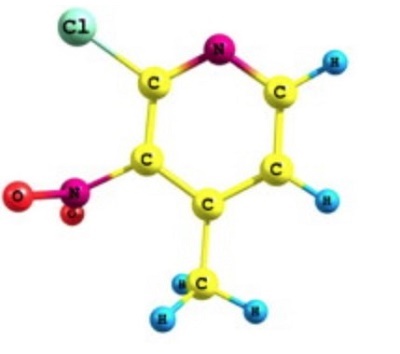2-Chloro-4-methyl-3-nitropyridine
|
|
|
- CAS-Nr.
- 23056-39-5
- Englisch Name:
- 2-Chloro-4-methyl-3-nitropyridine
- Synonyma:
- 2-Chloro-4-Methyl-3-NP;2-CHLORO-3-NITRO-4-PICOLINE;2-Chloro-3-nitro-4-picoline,98%;2-CHLORO-3-NITRO-4-METHYLPYRIDINE;2-CHLORO-4-METHYL-3-NITROPYRIDINE;3-Nitro-2-chloro-4-methylpyridine;2,Chloro-4-Methyl-3-3-nitropyridine;2-Chloro-4-methyl-3-nitropyridine>PYRIDINE, 2-CHLORO-4-METHYL-3-NITRO-;2-Chloro-4-methyl-3-nitropyridine 98+%
- CBNumber:
- CB9304053
- Summenformel:
- C6H5ClN2O2
- Molgewicht:
- 172.57
- MOL-Datei:
- 23056-39-5.mol
|
2-Chloro-4-methyl-3-nitropyridine Eigenschaften
- Schmelzpunkt:
- 51-53 °C (lit.)
- Siedepunkt:
- 279.6±35.0 °C(Predicted)
- Dichte
- 1.406±0.06 g/cm3(Predicted)
- Flammpunkt:
- >230 °F
- storage temp.
- Keep in dark place,Sealed in dry,Room Temperature
- L?slichkeit
- Chloroform (Slightly), DMSO (Slightly), Methanol (Slightly)
- pka
- -1.80±0.10(Predicted)
- Aggregatzustand
- Powder
- Farbe
- Yellow to beige
- Sensitive
- Hygroscopic
- InChI
- InChI=1S/C6H5ClN2O2/c1-4-2-3-8-6(7)5(4)9(10)11/h2-3H,1H3
- InChIKey
- JHARVUVBTAAPLA-UHFFFAOYSA-N
- SMILES
- C1(Cl)=NC=CC(C)=C1[N+]([O-])=O
- CAS Datenbank
- 23056-39-5(CAS DataBase Reference)
Sicherheit
- Risiko- und Sicherheitserkl?rung
- Gefahreninformationscode (GHS)
| Bildanzeige (GHS) |
 
|
| Alarmwort |
Warnung |
| Gefahrenhinweise |
| Code |
Gefahrenhinweise |
Gefahrenklasse |
Abteilung |
Alarmwort |
Symbol |
P-Code |
| H302 |
Gesundheitssch?dlich bei Verschlucken. |
Akute Toxizit?t oral |
Kategorie 4 |
Warnung |
![GHS hazard pictograms]() src="/GHS07.jpg" width="20" height="20" /> src="/GHS07.jpg" width="20" height="20" /> |
P264, P270, P301+P312, P330, P501 |
| H312 |
Gesundheitssch?dlich bei Hautkontakt. |
Akute Toxizit?t dermal |
Kategorie 4 |
Warnung |
![GHS hazard pictograms]() src="/GHS07.jpg" width="20" height="20" /> src="/GHS07.jpg" width="20" height="20" /> |
P280,P302+P352, P312, P322, P363,P501 |
| H315 |
Verursacht Hautreizungen. |
Hautreizung |
Kategorie 2 |
Warnung |
![GHS hazard pictograms]() src="/GHS07.jpg" width="20" height="20" /> src="/GHS07.jpg" width="20" height="20" /> |
P264, P280, P302+P352, P321,P332+P313, P362 |
| H319 |
Verursacht schwere Augenreizung. |
Schwere Augenreizung |
Kategorie 2 |
Warnung |
![GHS hazard pictograms]() src="/GHS07.jpg" width="20" height="20" /> src="/GHS07.jpg" width="20" height="20" /> |
P264, P280, P305+P351+P338,P337+P313P |
| H331 |
Giftig bei Einatmen. |
Akute Toxizit?t inhalativ |
Kategorie 3 |
Achtung |
![GHS hazard pictograms]() src="/GHS06.jpg" width="20" height="20" /> src="/GHS06.jpg" width="20" height="20" /> |
P261, P271, P304+P340, P311, P321,P403+P233, P405, P501 |
| H335 |
Kann die Atemwege reizen. |
Spezifische Zielorgan-Toxizit?t (einmalige Exposition) |
Kategorie 3 (Atemwegsreizung) |
Warnung |
![GHS hazard pictograms]() src="/GHS07.jpg" width="20" height="20" /> src="/GHS07.jpg" width="20" height="20" /> |
|
|
| Sicherheit |
| P261 |
Einatmen von Staub vermeiden. |
| P264 |
Nach Gebrauch gründlich waschen. |
| P264 |
Nach Gebrauch gründlich waschen. |
| P280 |
Schutzhandschuhe/Schutzkleidung/Augenschutz tragen. |
| P304+P340 |
BEI EINATMEN: Die Person an die frische Luft bringen und für ungehinderte Atmung sorgen. |
| P305+P351+P338 |
BEI KONTAKT MIT DEN AUGEN: Einige Minuten lang behutsam mit Wasser spülen. Eventuell vorhandene Kontaktlinsen nach M?glichkeit entfernen. Weiter spülen. |
| P405 |
Unter Verschluss aufbewahren. |
|
2-Chloro-4-methyl-3-nitropyridine Chemische Eigenschaften,Einsatz,Produktion Methoden
R-S?tze Betriebsanweisung:
R36/37/38:Reizt die Augen, die Atmungsorgane und die Haut.
R21/22:Gesundheitssch?dlich bei Berührung mit der Haut und beim Verschlucken.
S-S?tze Betriebsanweisung:
S26:Bei Berührung mit den Augen sofort gründlich mit Wasser abspülen und Arzt konsultieren.
S37/39:Bei der Arbeit geeignete Schutzhandschuhe und Schutzbrille/Gesichtsschutz tragen.
S36/37/39:Bei der Arbeit geeignete Schutzkleidung,Schutzhandschuhe und Schutzbrille/Gesichtsschutz tragen.
S36:DE: Bei der Arbeit geeignete Schutzkleidung tragen.
Chemische Eigenschaften
Light yellow Cryst
Verwenden
2-Chloro-4-methyl-3-nitropyridine is a cyclopropyldipyridodiazepinone derivative for use as non-nucleoside reverse transcriptase inhibitors.
Definition
2-Chloro-4-methyl-3-nitropyridine (2C4M3NP) is a nitropyridine derivative that could form an acceptor fragment of 2-adamantylamino-5-nitropyridine (AANP). This crystal shows a particularly large optical non-linearity. It is observed that the mean C-C (ring) bond distance calculated between the ring carbon atoms of 2C4M3NP is 1.387 Å. In X-ray data of pyridine, the mean C-C (ring) bond distance is 1.394 Å. The C-H bond distances are found to be 1.081 Å. The computed values of C-C (ring) and C-H are slightly higher than that of the experimental value. This is attributed to the substituents present in the pyridine. The C-C-C bond angle where the -Cl and -NO2 group is attached with the middle carbon is more than 120
? while the C-C-C bond angle where the -CH3 is substituted is less than 120
? in 2C4M3NP. The N-C-CH3 bond angle (116.3
。) is less than that of the C-C-CH3 (124.2
。) probably due to the weak hydrogen bond formed between the nitrogen and hydrogen of the methyl group[1].

Allgemeine Beschreibung
Experimental FTIR and FT-Raman spectroscopic analysis of 2-chloro-4-methyl-3-nitropyridine was reported.
2-Chloro-4-methyl-3-nitropyridine Upstream-Materialien And Downstream Produkte
Upstream-Materialien
Downstream Produkte
2-Chloro-4-methyl-3-nitropyridine Anbieter Lieferant Produzent Hersteller Vertrieb H?ndler.
Global( 384)Lieferanten
23056-39-5()Verwandte Suche:
- 2-Chloro-4-Methyl-3-NP
- 2-CHLORO-4-METHYL-3-NITROPYRIDINE
- 2-CHLORO-3-NITRO-4-METHYLPYRIDINE
- 2-CHLORO-3-NITRO-4-PICOLINE
- PYRIDINE, 2-CHLORO-4-METHYL-3-NITRO-
- 2-CHLORO-3-NITRO-4-PICOLINE (2-CHLORO-4-METHYL-3-NITROPYRIDINE)
- 3-Nitro-2-chloro-4-methylpyridine
- 2-Chloro-3-nitro-4-picoline,98%
- 2-Chloro-4-methyl-3-nitropyridine 98+%
- 2,Chloro-4-Methyl-3-3-nitropyridine
- 2-Chloro-4-methyl-3-nitropyridine>
- 2-Chloro-4-methyl-3-nitropyridine ISO 9001:2015 REACH
- 23056-39-5
- C6H5ClN2O2
- Pyridines
- Heterocyclic Building Blocks
- Halogenated Heterocycles
- Halopyridines
- Chloropyridines
- Building Blocks
- Non-nucleoside Reverse Transcriptase
- Amines
- Aromatics
- Heterocycles
- Pyridine
- Pyridines, Pyrimidines, Purines and Pteredines
- Pyridine series
- Heterocyclic Compounds
- Pyridines
- Chloropyridines
- Halopyridines
- Boronic Acid
- C6Heterocyclic Building Blocks
- Halogenated Heterocycles
- Heterocyclic Building Blocks
- Heterocycle-Pyridine series

